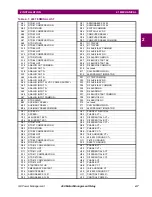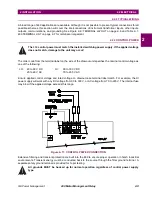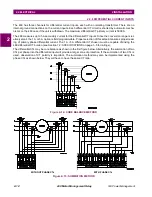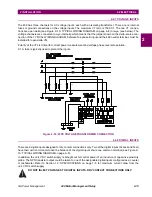
2-18
469 Motor Management Relay
GE Power Management
2.2 ELECTRICAL
2 INSTALLATION
2
2.2.12 OUTPUT RELAYS
There are six Form C output relays (see Section 1.2: SPECIFICATIONS on page 1–5 for details). Five of the
six relays are always non-failsafe; R6 Service is always failsafe. As failsafe, the R6 relay is normally energized
and de-energizes when called upon to operate. It also de-energizes when 469 control power is lost and will be
in its operated state. All other relays, being non-failsafe, will normally be de-energized and energize when
called upon to operate. When the 469 control power is lost, these relays are de-energized and in their non-
operated state. Shorting bars in the drawout case ensure that no trip or alarm occurs when the 469 is drawn
out. However, the R6 Service output will indicate that the 469 has been drawn out. Each output relay has an
LED indicator on the front panel that turns on when the associated relay is in the operated state.
•
R1 TRIP: The trip relay should be wired to take the motor off line when conditions warrant. For a breaker
application, the NO R1 Trip contact should be wired in series with the Breaker trip coil. For contactor appli-
cations, the NC R1 Trip contact should be wired in series with the contactor coil.
Supervision of a breaker trip coil requires that the supervision circuit be in parallel with the R1 TRIP relay
output contacts, as shown in Figure 2–10: TYPICAL WIRING DIAGRAM on page 2–8. With this connec-
tion made, the supervision input circuits place an impedance across the contacts that draws a 2 mA cur-
rent (for an external supply voltage from 30 to 250 V DC) through the breaker trip coil. The supervision
circuits respond to a loss of this trickle current as a failure condition. Circuit breakers equipped with stan-
dard control circuits have a breaker auxiliary contact permitting the trip coil to be energized only when the
breaker is closed. When these contacts are open, as detected by the Starter Status Digital Input monitor-
ing breaker auxiliary contacts, trip coil supervision circuit is automatically disabled. This logic allows the trip
circuit to be monitored only when the breaker is closed.
•
R2 AUXILIARY, R3 AUXILIARY: The auxiliary relays may be programmed for trip echo, alarm echo, trip
backup, alarm differentiation, control circuitry, and numerous other functions. They should be wired as con-
figuration warrants.
•
R4 ALARM: The alarm relay should connect to the appropriate annunciator or monitoring device.
•
R5 BLOCK START: The block start relay should be wired in series with the start push-button in either a
breaker or contactor configuration to prevent motor starting. When a trip has not been reset on a breaker,
the block start relay prevents a start attempt that would result in an immediate trip. Also, any lockout func-
tions are directed to the block start relay.
•
R6 SERVICE: The service relay operates if any of the 469 diagnostics detect an internal failure or on loss
of control power. This output may be monitored with an annunciator, PLC or DCS.
If it is deemed that a motor is more important than a process, the service relay NC contact may also be
wired in parallel with the trip relay on a breaker application or the NO contact may be wired in series with
the trip relay on a contactor application. This will provide failsafe operation of the motor; that is, the motor
will be tripped off line in the event that the 469 is not protecting it. If however, the process is critical, annun-
ciation of such a failure will allow the operator or the operation computer to either continue, or do a
sequenced shutdown. See Figure 2–22: ALTERNATE WIRING FOR CONTACTORS on page 2–19 for
details.
Содержание MOTOR MANAGEMENT RELAY 469
Страница 2: ......
Страница 4: ......
Страница 12: ......
Страница 22: ......
Страница 50: ......
Страница 142: ......
Страница 240: ......
Страница 254: ......
Страница 272: ......
Страница 286: ......
Страница 290: ......
Страница 294: ......
Страница 298: ......
Страница 300: ......
Страница 302: ......
















































